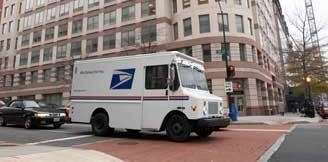House Democrats tell USPS to ‘go back to the drawing board’ on electric vehicle cost analysis
House Oversight and Reform Committee Chairwoman Carolyn Maloney (D-N.Y.) is telling the Postal Service to start over in determining how many electric vehicles it...
The top Democrat on the House Oversight and Reform Committee is telling the Postal Service to start over in determining how many electric vehicles it can afford to purchase as part of its 10-year next-generation delivery vehicle contract.
Committee Chairwoman Carolyn Maloney (D-N.Y.) said Tuesday that USPS “can and must increase the number of electric vehicles that it purchases.”
USPS agreed to share the analysis it’s been using to determine how many electric vehicles it will purchase, but Maloney said “it’s clear that the Post Office needs to go back to the drawing board.”
Maloney is specifically directing USPS to draft a new environmental impact study and a new cost estimate for electric vehicles, as well as “immediately renegotiate” a better price for electric vehicles with its vendor Oshkosh Defense, if the agency determines it’s being charged too much for them.
USPS, under pressure from Congress and the Biden administration, recently doubled its initial order for electric vehicles as part of its next-generation delivery vehicle fleet.
USPS spent nearly $3 billion on 50,000 next-generation vehicles as part of its initial order to the vendor Oshkosh Defense. More than 10,000 vehicles as part of that initial order are electric vehicles.
Vicki Stephen, executive director of the USPS Next Generation Delivery Vehicle program, said the agency was able to purchase more electric vehicles than it expected because of the rising cost of gasoline, as well as long-term savings the agency is counting on, now that Congress has passed the first major piece of postal reform legislation in 15 years.
Stephen said USPS remains flexible to purchase more electric vehicles as needed, as part of its $11 billion contract award to Oshkosh Defense. She said USPS, through “ongoing analysis,” will continue to keep an eye on changing fuel prices, and determine if it’s more cost-effective to purchase more electric vehicles.
“We’ve committed to doing ongoing updates as conditions change in the market, so I don’t think a new analysis is required. I think the analysis that we’ve prepared is well-designed to look at those variables and assess relative impact,” Stephen said.
But House Democrats said USPS is setting the bar too low on electrifying its delivery fleet, and is pushing for electric vehicles to make up as much as 75% of the agency’s next-generation fleet.
Maloney said Congress is currently considering a smaller, scaled-down version of the Build Back Better Act, and that “funding for the additional postal EVs could be in that bill.”
USPS, under an earlier version of the bill, would have received $6 billion to purchase more electric vehicles and charging stations. That version, however, doesn’t have the support it needs to pass in the Senate.
Stephen said the agency would purchase more electric vehicles than originally planned if Congress approves the funding.
“If the funding was made available to us, we would absolutely adjust our plans. Our plans today reflect what we can afford with our own resources,” she said.
If congressional funding doesn’t fall into place, members of the committee urged USPS to take some of the money saved under the Postal Service Reform Act and put it toward purchasing new electric vehicles.
The Senate passed the legislation in a 79-19 vote last month, and is expected to save USPS $107 billion in total. About half of those savings will happen over the next 10 years.
President Joe Biden is expected to sign the bill into law on Wednesday.
USPS currently has about $24 billion in cash. Of that, about $13 billion is allocated to pay down its debts.
However, Stephen said the agency is also focused on capital investments to upgrade other parts of its infrastructure.
“We’ve deferred maintenance, we’ve deferred investments. It’s not just our vehicles that are long overdue to be replaced,” Stephen said.
The agency is already spending $8 billion in capital investments this fiscal year, with about $4.7 billion going toward its next-generation delivery vehicle fleet. USPS also plans to spend $1.1 billion on facilities upgrades and $1.4 billion on processing equipment.
Stephen said USPS has an “urgent need” to replace its fleet. Many of its 190,000 delivery vehicles lack basic features that include air conditioning, airbags, and anti-lock brakes.
However, non-vehicle capital investments are also essential parts of the agency’s 10-year reform plan, and spending more of the Postal Service’s own money on electric vehicles would jeopardize the reform plan.
“There have been many things that have gone underinvested over the last many, many years, and so there are there other financial priorities that are competing for our resources to make sure that we’re addressing all of those needs, in addition to the delivery vehicles,” Stephen said.
USPS Inspector General Tammy Whitcomb told the committee that there are “definitely opportunities for significantly more electrification of the fleet.”
Jill Naamne, the acting director of the physical infrastructure team at the Government Accountability Office, said USPS used a 2020 gas price in its analysis that now is almost $2 per gallon less than the current national average.
Stephen said electric vehicles will cost USPS less to maintain than gas-powered vehicles, which is consistent with GAO’s findings.
However, Naamne said the formulas and models reviewed by GAO, which USPS uses to determine its mix of electric and gas-powered vehicles, indicate that electric vehicles are more expensive for them to maintain.
“This is one of the inconsistencies that we’ve seen in the information that we’ve gotten so far from the Postal Service,” Naamne said.
Kenny Stein, the director for policy at the Institute for Energy Research, told the committee that the expected lower operating costs of electric vehicles over their lifetime would not make up for a higher upfront cost, except in certain locations and certain routes.
“If those assumptions have proved overly optimistic, EVs could actually end up being a long-term financial drag on the Postal Service,” Stein said.
Committee Ranking Member James Comer (R-Ky.) said Republicans on the committee don’t oppose electrifying some of the USPS, but warned against making USPS a “guinea pig” for broader adoption of electric vehicles.
“While Republicans are not against the Postal Service acquiring electric vehicles, we’re against mandates that ignore the business needs and the financial situation of the Postal Service. Republicans believe the postal service must be self-funded. This means the Postal Service should pay for its own capital needs, like purchasing new vehicles,” Comer said.
Joe Britton, the Executive Director for the Zero-Emission Transportation Association, told the committee that USPS is “dramatically underestimating” the capabilities of electric vehicles.
USPS expects electric delivery trucks manufactured by Oshkosh Defense will be able to travel 70 miles per charge, but Britton said the current marketplace standard is double that range.
Britton said the $18,000 per EV charger estimated by USPS is “far more” than the current federal blanket purchase agreement already negotiated by the General Services Administration to install these same chargers for agencies.
“Unless they reverse course, they will continue to bear these unnecessary costs for both gasoline and service and maintenance, whereas their competitors will not,” Britton said.
Earlier this week, the Biden administration estimated that climate change’s toll on the federal government will become more expensive over time.
New assessments that are part of the administration’s fiscal 2023 budget request show the federal government could spend up to $128 billion a year to mitigate some of the effects of climate change by the end of the century.
This spending includes flood insurance, crop insurance, wildfire suppression and flooding at federal facilities.
The administration projects more than 12,000 federal buildings could be affected by flooding by the end of the century, with a total replacement cost of more than $43 billion.
“The Postal Service cannot ignore its responsibility to reduce the environmental impact of its fleet,” Maloney said.
Copyright © 2025 Federal News Network. All rights reserved. This website is not intended for users located within the European Economic Area.
Jory Heckman is a reporter at Federal News Network covering U.S. Postal Service, IRS, big data and technology issues.
Follow @jheckmanWFED
Related Stories






